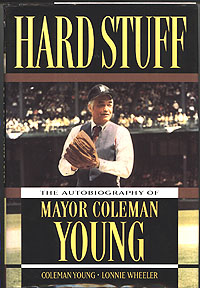





by Coleman Young and Lonnie Wheeler

Reviewed by Theresa Welsh
|
I'll say this for Detroit Mayor Coleman A. Young: He was an original! I was living in Detroit while Young was mayor, along with my husband, David, and later our daughter who was born in 1985. We were among the dwindling number of white people still residing in what Mayor Young told us was the "blackest city in America." In our case, neither of us had grown up in Detroit, but had willingly moved there and, when the 1967 riot started, we had been recently married and were living in an apartment very near where the riot began. Mayor Young makes a big deal out of white people abandoning the city and about that, he is correct. White people left Detroit in huge numbers after the riot, accelerating a trend that was already underway. How Coleman Young Got That WayI begin my review this way because for Coleman Young, race seemed to define everything. He was an incredibly abrasive person, rarely passing up a chance to "stick it to the man." This book has given me a new understanding of how Coleman Young got to be Coleman Young. He grew up in Black Bottom, a black neighborhood that was later bulldozed for "urban renewal," a process called "Negro removal" by those who lived there. This near East Side area was the only neighborhoods where black people could reside. Black Bottom and Paradise Valley were home to many famous jazz clubs (this was before Motown), and from Young's account, it is clear that the area around Hastings Street was a vibrant place where black culture thrived and people got to know each other. (Today, Hastings Street has been replaced by the Chrysler Freeway) In this environment, the youthful Coleman Young learned to be a hustler, a bootlegger, a charmer, and a radical. He liked to hang around Maben's Barber Shop, where political talk was more popular than getting a trim. A Hero on the Streets of DetroitIt is clear from what he says in the book that Coleman Young relished the fight even more than the victory. He was defiant against the prevailing racism, including a stint in the army during World War II where he trained as a Tuskegee Airman, but never actually served in the war because his white superiors washed him out because of his political views and radical activity. He was on the FBI watch list from his earliest days and testified before the House Un-American Activities Committee (HUAC) where his defiance against the bigoted committee members made him a hero on the streets of Detroit. Young was active in union organizing from an early age, but he never held an actual union job for any length of time and later, as mayor, had to play hardball with city unions, including the hated DPOA (Detroit Police Officers Association). I learned some surprising things about him in this book, like the fact that he was married (and divorced) twice. In both cases, his wife became pregnant but lost the baby. In the first case, he says his wife was left in a hospital waiting room while he ran around trying to borrow money so she could be treated. He admits to being a poor husband and lousy provider. He wanted to have a son, but this wish was not fulfilled until he was an old man and a paternity test revealed him the father of Annivory Calvert's child. She was a city worker who was moving to California and wanted child support from Coleman Young, with whom she had a relationship. I remember this case well, and it was typical Coleman Young to fight even this woman who only wanted something for her son. Young did finally acknowledge the boy as his and supported him very well. In recent years, this son of Coleman Young has reappeared, having taken the name to "Coleman Young, Jr" and has returned to Detroit to seek a political career. With a legend for a father, it's a lot to live up to. Speaking of fathers, Coleman Young loved and respected his own father who was a master gambler. He was also so light-skinned he could (and sometimes did) pass for white. But he also despised white people because the fact that whites usually did not know he was black meant they would reveal their full bigotry in front of him. Young is almost silent about his mother. I wish he had written more about her. The book begins with Young's ancestry in the South, and shows that Coleman Young, who fought so passionately for blacks, has a lot of white in him, a legacy of racial mixing on the plantations. From Black Bottom to Poletown and BeyondSo what did Coleman Young, Detroit mayor for 20 years, accomplish for the city? He was the force behind getting a General Motors factory built where the old Dodge Main plant had been, but it meant taking out hundreds of homes in an area known as Poletown. I well remember how contentious this was, with the priest at Immaculate Conception church and a group of neighborhood loyalists vowing they would stand in the way of the bulldozers. Ironic, isn't it, that the man who watched his own neighborhood taken to build fancy highrise buildings for white people presided over the dismantling of another neighborhood named for its original Polish settlers. Young also spearheaded the building of a Chrysler factory on the East Side. He fought for these factories because they meant jobs, and he felt nothing was more important than jobs in the city. However, neither of these factories has produced the number of jobs expected, which is not Coleman Young's fault, but just part of the general decline of the American automobile industry. Most of the people who work in those auto plants now do not live in the city, but drive in from the suburbs. Young also expanded City Airport (now called Coleman A. Young International Airport), which meant taking out part of Six Mile Road. The airport briefly had some commercial airlines, but now just serves private planes, charters and freight. The area to the west of the airport has lost so many homes to abandonment that much of it is going back to nature. I wonder if taking out Six Mile Road might be a factor. But maybe not, since there are vast empty tracts throughout the city. Cleaning Up the Police DepartmentColeman Young was right about many things, and his desire to right the wrongs that blacks suffered for so many years is understandable. He brought the racial makeup of the police department to 50/50 and ended the blatant brutality of the formerly mostly white department against the black citizens of the city. This benefited all of us because police brutality was clearly the cause of the 1967 riot. Of course, Mayor Young pissed off much of the white population in the way he doled out slots in the police department and he made the police union (DPOA) into public enemy number one. During the years we lived in Detroit, the police service was beyond terrible -- if you called the police, you had to tell them someone was axing innocent people in the street before they would come. We had our house robbed a number of times and one time the neighbors saw it and called the police, but they could not be bothered to come for a mere house break-in. Mayor of All Detroit or Just Black Detroit?I confess that I never could bring myself to vote for Coleman Young. I felt he was mayor of black Detroit, but not of white Detroit. I may have been mistaken about that in the sense that Mayor Young DID want to see black and white working together. He realized our destinies were entwined, and he was always ready to sit down with the white power brokers like Henry Ford II (known locally as Hank the Deuce), wealthy philanthropist Max Fisher, and downriver industrialist Heinz Prechter. He also worked well with President Jimmy Carter (from whom he got big bucks for the city) and Republican Governor William Milliken (who was also my all-time favorite Republican). I'm afraid I'm one of those "bleeding-heart Liberals" who Mayor Young loved to sneer at, claiming we did not have the same junkyard dog instincts for the fight as he had. Well, that's true, but why did this man have to constantly throw barbs at people who could have been his allies? Reading this book gives me some insight into possible answers to that question. Read and LearnI thoroughly enjoyed this fascinating book, with its colorful Mayor Young language (be prepared for lots of "m--f--" and "da--" and other bleepable words) and a picture section with some really great images. It was a nostalgic trip down memory lane, and a learning experience too. If you are interested in the history of Detroit, especially how it got to be a city of constantly shrinking population, this book provides some real food for thought. Coleman A. Young passed away in 1997. I wonder what he would think of the state of his city today, with its constantly shrinking population and empty lots where there used to be nighborhoods. Rest in Peace, Mr. Mayor. 2015 - EXTRA NOTE: What would Mayor Young think of the latest developments: A white man (Mike Duggan) being elected mayor and the city fresh out of bankruptcy and showing signs of a real rebirth? History is full of surprises!
Click below to go to amazon.com page for this book: See my Detroit essays and photos |
|
 |
 |